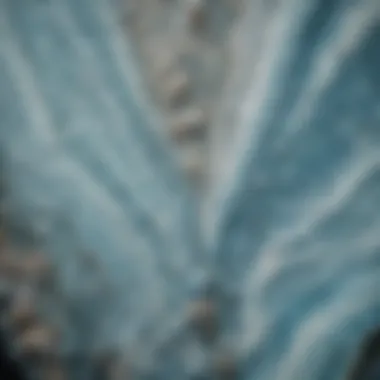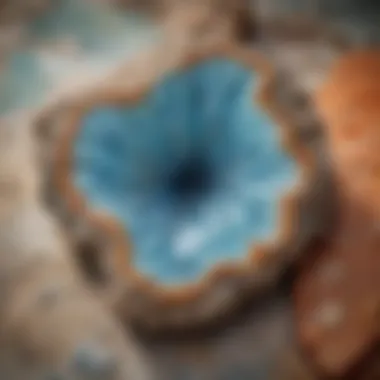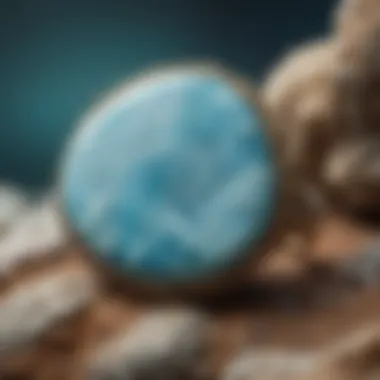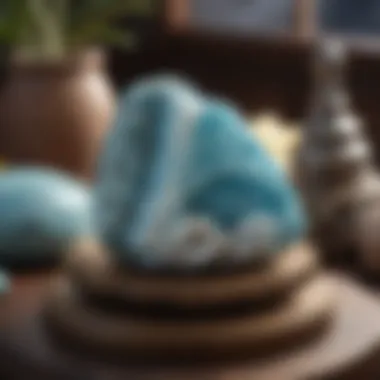Larimar Slabs: Geological Origins and Collectibility


Intro
This article discusses larimar slabs, fascinating geological formations found in the Caribbean. Understanding larimar's origins, unique properties, and values in collecting enhances appreciation for this stone. Larimar, known for its stunning blue hues, exclusively comes from the Dominican Republic. Volcanic activity in this region is key to its creation.
This guide provides insight into the physical characteristics of larimar, its uses in artistic applications, and the importance of ethical sourcing within the collecting community. Moreover, readers will find practical advice on collecting, valuating, and displaying their larimar specimens. The goal is to offer thoughtful knowledge that enriches one’s understanding of this exceptional geological material.
Rock and Fossil Identification
Identifying larimar slabs requires observation and certain tools. Here are key characteristics to look for when determining the authenticity of larimar:
- Color: Real larimar shows a range of blue shades, often with white patterns resembling clouds.
- Texture: The surface should feel smooth and polished. Textured or rough surfaces may indicate imitation.
- Transparency: Genuine larimar is often semi-translucent.
Types of Rocks and Fossils
When collecting larimar, it's crucial to distinguish it from other minerals. Larimar is a pectolite mineral variant, making its identification straightforward once familiar with its traits. Other similar stones may include certain turquoise varieties, but they lack the distinct patterns of real larimar.
Characteristics to Look For
When examining a piece, one should pay close attention to the inclusions within. These natural imperfections contribute to larimar’s allure. Noting any inconsistencies can also help to authenticate the stone.
Tools for Identification
Collecting enthusiasts should have these tools handy:
- Magnifying glass: Helps to observe details.
- UV light: Some stones react differently under UV light, offering hints to their authenticity.
- Measuring tools: For those who want to note the size and weight of slabs.
Geological Insights
Understanding the geological processes that form larimar provides deeper appreciation. Larimar is found within volcanic rocks, formed through a combination of heat and pressure.
Geological Formations and Processes
The unique blue color results from the presence of copper within the mineral structure during formation. This occurs under specific conditions typical in the volcanic regions of the Dominican Republic.
Historical Significance of Rocks and Fossils
Discoveries of larimar date back to the 1970s. Before this time, the stone remained largely unknown outside the local communities. Its introduction to the market marked both geological and economic shifts in the region.
Notable Discoveries in the Field
Among noteworthy finds, there are particularly large and uniquely patterned slabs that drew interest from collectors worldwide. These findings have expanded the knowledge of natural resources in the region and provided income to local artisans.
Collecting Tips and Techniques
For those eager to collect larimar, there are specific strategies to employ to maximize success.
Best Practices for Collecting
Careful handling and documentation of specimens is essential. Noting the origin of each piece maintains its collector value. Keeping track of reputable sources also helps ensure ethical purchasing.
Locating Prime Collecting Sites
When seeking larimar, focus on specific regions in the Dominican Republic, especially in Seybo Province. Finding local vendors is an excellent way to acquire unique specimens while supporting the community.
How to Safely Extract Specimens
If extracting larimar from the source, ensure that safety equipment—such as gloves and goggles—is used. Respecting the environment and adhering to local regulations is also crucial.
Preservation and Display
After acquiring larimar, it's essential to preserve its beauty and integrity. Keeping the slabs in a controlled environment prevents damage and loss of value.
Techniques for Preserving Rocks and Fossils
Utilizing low-humidity spaces is beneficial. Temperature changes can cause cracks. Also, avoid direct sunlight which may alter color over time.
Proper Storage Methods


Consider using acid-free boxes or cushioned containers for storage. It’s important to keep them separate from other materials to avoid scratches or damage.
Creative Display Ideas
Display can greatly enhance appreciation. Unique stands or shadow boxes highlight the beauty of each slab. In addition, educational labels can inform viewers about the origin and characteristics of the pieces.
"Understanding the geological formation and sourcing of larimar enriches the collecting experience and promotes responsible practices."
In this guide, we have explored the various aspects of larimar slabs, emphasizing key characteristics, preservation methods, and collecting strategies. Engaging with this stone not only unveils artistic beauty but also fosters awareness of ethical responsibilities in sourcing.
Preface to Larimar Slab
Larimar is not just a beautiful stone; it represents a story of natural wonder and human creativity. This section serves as a critical foundation within the article, emphasizing the significance of larimar in the realms of geology, art, and collectibility. By understanding what larimar is and its historical backdrop, readers gain valuable insights that enhance their appreciation for this unique gemstone.
Defining Larimar
Larimar is a rare pectolite mineral, notable for its stunning blue hues that evoke the Caribbean Sea. The name "larimar" is derived from a combination of the name of the daughter of the discoverer, Miguel Mendez, and the Spanish word for sea, "mar." The stone's color can range from light blue to deep blue, sometimes mixing with greens or whites. This distinctive coloration results from the presence of copper within the mineral structure.
Larimar is sourced exclusively from the Dominican Republic, primarily in the Barahona province. The specific geological conditions that contribute to the formation of larimar slabs are unique, making the stone even more special for collectors. As a result, they may seek out larimar not only for its beauty but also for its rarity.
Historical Context
The history of larimar is relatively brief compared to other gemstones, yet it is rich and fascinating. Discovered in the 1970s, larimar's modern introduction to the world can be attributed to a local Dominican artisan, who stumbled upon the stone along the shores of the Caribbean. This discovery prompted further exploration and mining in the region.
Historically, larimar's cultural significance holds weight within the Dominican Republic. It was used in local crafts long before it gained international recognition. Over time, it has become a symbol of the country, often associated with its serene landscapes and vibrant marine life.
In summary, defining larimar and understanding its historical context are essential for anyone interested in its collectibility, beauty, and unique features. The blend of natural rarity and cultural relevance contributes to the overall appeal of larimar slabs, making them a sought-after item among collectors and gemstone enthusiasts alike.
Geological Formation of Larimar
The geological formation of larimar is central to understanding its uniqueness and value. This section details how larimar is born from volcanic activity and its mineral makeup, as well as the extraction processes that bring this captivating stone to collectors. Understanding these aspects enhances appreciation for larimar and sheds light on its significance within geological and artistic communities.
Volcanic Origins
Larimar shines a light on the volcanic processes that shape our planet. Found exclusively in the Dominican Republic, this stone originated from a specific set of volcanic eruptions over millions of years.
The magma, which erupts from underground, encompasses various minerals. As it cools and interacts with seawater, a rich environment forms for the creation of blue pectolite, the mineral from which larimar is derived. The unique blue color is a result of copper ions mixing with the base mineral.
This volcanic context not only determines larimar's aesthetic qualities but also highlights the geological processes that give rise to gemstone formations. Each larimar slab can be seen as a piece of history, encapsulating the earth's geological activity.
Mineral Composition
To appreciate larimar fully, one must consider its mineral composition. Larimar primarily consists of pectolite, a mineral known for its fibrous structure. Specifically, the unique blue hue emerges from the presence of copper within the pectolite matrix. This contributes to its desirability and rarity.
Other minerals, such as quartz, can also be present, adding to the depth of color and enhancing the slab's overall appeal. The combination of these minerals plays a crucial role in determining the slab’s qualities, including its durability and texture, both of which are significant for collectors.
It's important to note that no two larimar slabs are the same. Variability in mineral concentrations, along with the geological conditions during formation, leads to a remarkable range of colors and patterns, which enhances its collectibility.
Extraction Processes
The extraction of larimar is intricate and requires careful attention to preserve its qualities. Local miners employ various techniques to retrieve larimar from the earth. Historically, mining was done using rudimentary tools, but as demand grew, methods improved.
Today, miners still use manual methods. The extraction mostly occurs in small tunnels, minimizing environmental impact. This labor-intensive work ensures that larimar remains an ethically sourced gem, resonating with collectors who value sustainable practices.
Once extracted, the slabs are cut and polished, revealing the stunning colors and textures hidden within. Collectors must be discerning, as the craftsmanship involved in the finishing of these slabs greatly influences their quality and market value.
"Understanding the geological formation and extraction of larimar not only enhances its allure but also emphasizes the effort behind each unique piece collectors cherish."
In summary, the geological formation of larimar intertwines its origins, mineral composition, and extraction processes, which are essential for appreciating this beautiful stone. Each larimar slab tells a story, connecting collectors to the rich geological heritage of the Dominican Republic.
Physical Properties of Larimar Slab
Understanding the physical properties of larimar slab is essential for rock and fossil collectors, as these characteristics determine its aesthetic appeal, durability, and overall value. Larimar is not just visually striking; its unique features play a significant role in how it is perceived in both artistic and collectible spheres. Recognizing these attributes allows collectors to make informed decisions, elevate their collections, and appreciate the slab's geological heritage more deeply.
Color Variations
Larimar exhibits a range of captivating color variations, typically in shades of blue, green, and white. The most sought-after hue is a rich, oceanic blue resembling the Caribbean sea. Other variations include soft shades of light blue and deep turquoise. The colors result from the mineral composition and the way light interacts with the stone.


Color intensity can also indicate quality. A slab with vibrant blue tones is often more collectible and can demand higher market value. Some pieces also display white streaks or a marbling effect, which adds to their uniqueness and beauty. Collectors should be aware that these variations can affect both the aesthetic appeal and the price of the slab, making it vital to consider color when evaluating larimar.
Texture and Finish
The texture and finish of larimar slab is an important aspect for collectors. Larimar typically has a smooth finish, enhancing its visual qualities and making it pleasant to the touch. However, some slabs may have a more natural, rough texture, which can appeal to those seeking an organic look. The choice between polished and raw texture often depends on personal preference and intended use.
Different finishing techniques can influence the stone's reflective qualities. A high-polish finish will enhance the vibrant colors and create a glossy surface, while a matte finish may lend a more subtle and subdued appearance. Both options offer distinct aesthetic values, so understanding the implications of texture and finish plays an important role in the appreciation of larimar.
Durability and Hardness
Durability is a key consideration when evaluating the collectibility of larimar. This stone rates between 4.5 to 5 on the Mohs scale, indicating that it is relatively soft compared to other gemstones. While this softness makes it easier to carve and shape, it also means larimar is susceptible to scratches and damage. Collectors should be aware of this softness, and take appropriate measures to care for their pieces, particularly if they are using them in everyday jewelry.
Considering its durability, understanding how to handle larimar slabs properly is crucial. Storing them away from harder stones and in protective cases can help maintain their condition over time. Moreover, the hardness plays a role in the overall market value; slabs that show minimal wear and maintain their aesthetic appeal are generally more desirable.
"The beauty and uniqueness of larimar slabs lie in their physical properties, which can affect not only individual preference but also their market demand and value."
In summary, the physical properties of larimar slab encompass essential elements such as color variations, texture, and durability. Each aspect holds significant importance for collectors. By focusing on these details, individuals can make informed decisions, leading to a deeper appreciation of this captivating geological specimen.
Artistic and Decorative Applications
The artistic and decorative applications of larimar slabs underscore the unique qualities and versatility of this gemstone. Beyond being a geological wonder, larimar has become a favored choice in both traditional and contemporary art forms. Its aesthetic appeal not only captures the eye, but also resonates with collectors and artisans alike.
Jewelry Making
Larimar is perhaps best known for its use in jewelry making. The unique blue hues of the stone mimic the tranquil seas of the Caribbean, evoking a sense of calm and beauty. Artisans often incorporate larimar into various types of jewelry, including pendants, earrings, and bracelets.
This gemstone is often paired with silver or gold, creating stunning contrasts that enhance its natural beauty. The production process can vary significantly among jewelers, with some opting for raw, unpolished pieces to maintain a rugged charm, while others create finely crafted, polished designs. Such diversity makes larimar a versatile material in the jewelry market. Additionally, its relative rarity adds to its allure, making each piece a potential collector's item.
Home Decor
Larimar slabs are increasingly popular in home decor. The vibrant colors lend a coastal, serene feel to any space. Many collectors and designers use larimar as tabletops, coasters, or decorative wall art.
Incorporating larimar into interior design can provide a unique focal point. Consider using large slabs as statement pieces, which can easily enhance the ambiance of a room. The natural patterns of larimar are one of a kind, providing a sense of authenticity to home decor.
Moreover, larimar can also be found in sculptures or decorative objects. Homeowners often seek out these pieces not only for their beauty but also for the calming energy they are thought to bring into a space. This aspect of larimar appeals particularly to those who value both aesthetics and elements of holistic living.
Craftsmanship Techniques
The craftsmanship techniques associated with larimar are critical for showcasing its beauty. Skilled artisans take great care when cutting and polishing larimar to ensure that the unique characteristics of each slab remain visible. The techniques used can range from traditional methods to more modern approaches, depending on the desired outcome.
Carving larimar requires precision, as the stone's properties can vary based on the mineral composition. Artisans often use water saws for cutting, which prevents overheating and cracking. This technique allows for more intricate designs while keeping the natural integrity of the stone.
The finishing processes also vary: some artisans use hand-polishing, while others may employ mechanical polishing methods. This attention to detail is necessary, as it enhances the stone's reflectivity and durability.
In summary, the artistic and decorative applications of larimar not only highlight its physical properties but also demonstrate its cultural significance. From jewelry making to home decor and craftsmanship, larimar continues to captivate audiences around the world.
The Collectible Nature of Larimar Slab
The collectible nature of larimar slab is profoundly interesting for enthusiasts and collectors alike. To understand its significance, one must consider various aspects such as market demand, factors influencing its collectibility, and how to evaluate quality. The unique appeal of larimar, both as a geological specimen and as a decorative piece, contributes to its growing popularity in collecting circles.
Market Demand and Value
Market demand for larimar has surged in recent years. Its exquisite color, reminiscent of the Caribbean sea, adds to its allure. The demand often outstrips supply due to its limited geographic origin in the Dominican Republic. High-quality larimar, particularly slabs with deep blue hues or striking patterns, can command high prices in the market. The value is not solely based on aesthetics; the rarity of large and flawless pieces amplifies their worth. Collectors often seek to invest in larimar for both its beauty and future appreciation.
The fluctuating prices can also reflect broader economic conditions. During times of economic expansion, collectors may be more willing to invest in higher-priced specimens. Conversely, in economic downturns, demand may decrease. Yet, larimar often retains value better than many other collectible stones due to its intrinsic beauty and limited availability.
Factors Influencing Collectibility
Several key factors influence the collectibility of larimar. First, its unique visual properties play a crucial role. The variations in color and pattern can make certain pieces much more desirable than others. Slabs that showcase a vibrant blue or intricate swirls often attract collectors.
Second, the provenance of the larimar is important. Pieces that come with a well-documented history or from reputable sources usually hold greater value. Collectors appreciate understanding where a specimen came from and its journey before reaching their hands.
Lastly, awareness and educational resources about larimar are essential. As collectors become more informed about its significance and qualities, they are more likely to invest in it. Greater engagement through platforms like Reddit and specialized collector forums has elevated interest in larimar.
Evaluating Quality
When evaluating larimar slabs, several criteria can assist collectors in discerning quality. Color depth is paramount. Deep blue and light blue shades are most prized, but any color variation can have its appeal. The presence of white and green hues can add character but should not dilute the overall aesthetic.


The texture and finish of the slab are also crucial. A polished surface should reflect light beautifully without any visible scratches or flaws. Intricate patterns that enhance the visual appeal can also elevate a slab's desirability.
Finally, collectors should consider the size. Larger pieces are often viewed as more collectible, though small slabs with exceptional color or pattern may also hold great value. It is important to consult guides or connect with experienced collectors to learn more about what constitutes a quality larimar slab.
The exploration of these factors offers insights into the world of larimar collecting. As collectors deepen their understanding, their appreciation for this unique stone continues to grow.
Sourcing and Ethical Considerations
Sourcing larimar involves a combination of geological uniqueness and responsible practices. The focus on ethical considerations is crucial. This ensures that the benefits of larimar mining extend beyond economic gain. It also safeguards the environment and supports local communities. The impact of mining on ecosystems can be significant. Therefore, understanding sustainable practices is essential for collectors and enthusiasts alike.
Sustainable Mining Practices
Sustainable mining practices are about balancing resource extraction with ecological conservation. Larimar mining takes place primarily in the Dominican Republic. Potential environmental impacts include habitat destruction and water pollution. Therefore, it is important to adopt eco-friendly methods that minimize these effects.
Several organizations and local governments are evaluating how mining operations can reduce their ecological footprint. Successful approaches include:
- Responsible waste management: Ensuring that mining waste does not enter local waterways.
- Land reclamation: Restoring mining sites after extraction to prevent soil erosion.
- Minimal land disturbance: Using techniques that limit the area affected by mining operations.
By implementing these practices, the industry can promote environmental stewardship. Consequently, collectors can feel assured that their acquisitions support sustainable efforts.
Impact on Local Communities
Mining has a profound impact on local communities in the Dominican Republic. It plays a pivotal role in their economic development. However, along with potential economic benefits come challenges that must not be overlooked.
Larimar mining can offer jobs and stimulate local businesses. Yet, it is vital to approach these aspects with caution. Workers in the mining sector often face unsafe conditions, long hours, and limited pay.
To improve this, several initiatives have been started, focusing on:
- Fair wages: Ensuring miners receive adequate compensation for their work.
- Worker rights education: Providing training on workers' rights and safety protocols.
- Community investment: Encouraging mining companies to invest in local infrastructure and education.
Supporting local communities not only helps improve worker conditions but also enhances the reputation of larimar as a collectible gemstone. Ethical sourcing, therefore, goes beyond just the product itself; it engages with the people and environments connected to its supply chain.
"Supporting sustainable and ethical practices in larimar mining not only preserves the stone's beauty but also fosters a better future for local communities."
Through ethical sourcing and sustainable practices, collectors can further appreciate their items. This cultivates a deeper connection with the cultural and social contexts of larimar.
Caring for Larimar Slab
Caring for larimar slab is crucial for maintaining its beauty and value. This unique stone, known for its stunning colors and rarity, requires specific attention to ensure its longevity. The way you care for your larimar can affect not only its aesthetic appeal but also its structural integrity.
Cleaning Techniques
When it comes to cleaning larimar slabs, a gentle touch is necessary. The stone can be sensitive to harsh chemicals and abrasive materials. To clean your larimar, use the following techniques:
- Use Warm Soapy Water: Mix a mild liquid soap with warm water. Dip a soft cloth or sponge in the solution and gently wipe the surface of the slab. Avoid soaking it, as excess moisture can be detrimental.
- Soft, Non-Abrasive Cloths: Always opt for soft microfiber cloths. These will ensure that you do not scratch or dull the surface.
- Avoid Strong Chemicals: Refrain from using bleach or ammonia-based cleaners. These can erode the stone's natural sheen.
- Dry Thoroughly: After washing, make sure to dry the slab completely with another soft cloth. This will prevent water spots and residue from forming.
Storage Recommendations
Proper storage of larimar slabs is vital to preserve their condition. Here are some recommendations to consider:
- Store in a Soft Pouch: Use a soft cloth pouch or a fabric-lined box to keep the slab protected from scratches. This also prevents it from coming into contact with other harder materials.
- Avoid Direct Sunlight: Find a cool, dry place for storage, away from direct sunlight. Prolonged exposure can cause fading of the vivid colors.
- Maintain Temperature and Humidity: Ideally, store larimar in a climate-controlled area. Extreme temperature fluctuations may affect the stone's structure.
"Larimar slabs are more than just decorative items; they are geological treasures that deserve careful attention."
By following these guidelines, you can ensure that your larimar slab remains as stunning as the day you acquired it. This will not only enhance your personal enjoyment but also maintain its appeal in the eyes of future collectors.
Ending: The Enduring Appeal of Larimar Slab
The conclusion of this article reflects on the profound attraction of larimar slab as both a geological wonder and a sought-after collectible. Larimar captivates not only through its unique turquoise hues and patterns but also due to its exclusive origin from the Dominican Republic. This locality adds a layer of intrigue and rarity that appeals to collectors and casual enthusiasts alike.
Final Thoughts on Collectibility
When considering the collectibility of larimar slab, it is essential to acknowledge several key aspects. First, the inherent beauty of the stone makes it a desirable item in the realm of gem collecting. Its variations in color and pattern can signify the authentic allure of each piece. Furthermore, as the interest in larimar grows, so does its market demand, which can ultimately influence its value over time.
It's crucial for collectors to stay informed about the factors that impact larimar's market, including supply constraints and ethical sourcing practices. By understanding these elements, collectors can better navigate their acquisitions and appreciate the worth of their collections. Knowing how to evaluate quality will set informed collectors apart, enhancing both their investment and appreciation of the stone.
The Future of Larimar in Collecting
Looking ahead, the future of larimar in the collecting world seems promising. As awareness of this unique material increases, more collectors are likely to seek out larimar items, both for personal use and investment. The combination of its geological significance and stunning aesthetics provides a solid foundation for ongoing interest.
Additionally, advancements in information sharing via platforms like Reddit and social media will help facilitate greater discourse around larimar. This can empower new collectors with insights into market trends, ethical considerations, and creative uses of larimar in various forms.
As a result, larimar could very well remain a focal point in the realms of geology and collecting, maintaining its position as an object of fascination.







